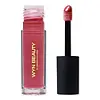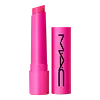Wyn Beauty Acceptance Speech Shimmering Hydrating Lip Gloss Versus Mac Cosmetics Squirt Plumping Gloss Stick
What's inside
What's inside
 Key Ingredients
Key Ingredients

 Benefits
Benefits

 Concerns
Concerns

 Ingredients Side-by-side
Ingredients Side-by-side

Polybutene
Octyldodecanol
EmollientBis-Diglyceryl Polyacyladipate-2
EmollientTricaprylin
MaskingSynthetic Wax
AbrasiveSilica Dimethyl Silylate
EmollientVp/Eicosene Copolymer
Vp/Hexadecene Copolymer
Mica
Cosmetic ColorantButyrospermum Parkii Butter
Skin ConditioningRicinus Communis Seed Oil
MaskingAroma
Sorbitan Oleate
EmulsifyingCaprylyl Glycol
EmollientPhenoxyethanol
PreservativeHexylene Glycol
EmulsifyingSodium Hyaluronate
HumectantHydrogenated Castor Oil
EmollientOlus Oil
EmollientCI 77891
Cosmetic ColorantCI 17200
Cosmetic ColorantIron Oxides
CI 15850
Cosmetic ColorantPolybutene, Octyldodecanol, Bis-Diglyceryl Polyacyladipate-2, Tricaprylin, Synthetic Wax, Silica Dimethyl Silylate, Vp/Eicosene Copolymer, Vp/Hexadecene Copolymer, Mica, Butyrospermum Parkii Butter, Ricinus Communis Seed Oil, Aroma, Sorbitan Oleate, Caprylyl Glycol, Phenoxyethanol, Hexylene Glycol, Sodium Hyaluronate, Hydrogenated Castor Oil, Olus Oil, CI 77891, CI 17200, Iron Oxides, CI 15850
Diisostearyl Malate
EmollientPolybutene
Polyglyceryl-2 Triisostearate
EmulsifyingBis-Diglyceryl Polyacyladipate-2
EmollientCaprylic/Capric Triglyceride
MaskingMicrocrystalline Wax
Emulsion StabilisingSynthetic Wax
AbrasiveSodium Hyaluronate
HumectantButyrospermum Parkii Butter
Skin ConditioningPersea Gratissima Oil
Skin ConditioningGlycine Soja Oil
EmollientCapsicum Frutescens Fruit Extract
Skin ConditioningZingiber Officinale Root Oil
MaskingMenthoxypropanediol
MaskingStearalkonium Hectorite
Gel FormingMenthol
MaskingParaffin
PerfumingIsohexadecane
EmollientHydrogenated Coconut Oil
EmollientVanillyl Butyl Ether
MaskingHydrogenated Polyisobutene
EmollientMethyl Nicotinate
SoothingTripeptide-1
Skin ConditioningPropylene Carbonate
SolventEthylene/Propylene Copolymer
AbrasiveEthylene/Propylene/Styrene Copolymer
Butylene/Ethylene/Styrene Copolymer
Xanthan Gum
EmulsifyingTin Oxide
AbrasiveSynthetic Fluorphlogopite
Caprylyl Glycol
EmollientHexylene Glycol
EmulsifyingVanillin
MaskingPentaerythrityl Tetra-Di-T-Butyl Hydroxyhydrocinnamate
AntioxidantPhenoxyethanol
PreservativeMica
Cosmetic ColorantCI 77891
Cosmetic ColorantCI 77491
Cosmetic ColorantCI 77492
Cosmetic ColorantCI 77499
Cosmetic ColorantCI 77163
Cosmetic ColorantCI 42090
Cosmetic ColorantCI 77400
Cosmetic ColorantCI 77742
Cosmetic ColorantCI 15850
Cosmetic ColorantCI 45380
Cosmetic ColorantCI 45410
Cosmetic ColorantCI 73360
Cosmetic ColorantCI 17200
Cosmetic ColorantCI 19140
Cosmetic ColorantCI 15985
Cosmetic ColorantDiisostearyl Malate, Polybutene, Polyglyceryl-2 Triisostearate, Bis-Diglyceryl Polyacyladipate-2, Caprylic/Capric Triglyceride, Microcrystalline Wax, Synthetic Wax, Sodium Hyaluronate, Butyrospermum Parkii Butter, Persea Gratissima Oil, Glycine Soja Oil, Capsicum Frutescens Fruit Extract, Zingiber Officinale Root Oil, Menthoxypropanediol, Stearalkonium Hectorite, Menthol, Paraffin, Isohexadecane, Hydrogenated Coconut Oil, Vanillyl Butyl Ether, Hydrogenated Polyisobutene, Methyl Nicotinate, Tripeptide-1, Propylene Carbonate, Ethylene/Propylene Copolymer, Ethylene/Propylene/Styrene Copolymer, Butylene/Ethylene/Styrene Copolymer, Xanthan Gum, Tin Oxide, Synthetic Fluorphlogopite, Caprylyl Glycol, Hexylene Glycol, Vanillin, Pentaerythrityl Tetra-Di-T-Butyl Hydroxyhydrocinnamate, Phenoxyethanol, Mica, CI 77891, CI 77491, CI 77492, CI 77499, CI 77163, CI 42090, CI 77400, CI 77742, CI 15850, CI 45380, CI 45410, CI 73360, CI 17200, CI 19140, CI 15985
 Reviews
Reviews

Ingredients Explained
These ingredients are found in both products.
Ingredients higher up in an ingredient list are typically present in a larger amount.
This ingredient is lipid-based synthetic skin-conditioning agent derived from adipic acid and a mixture of fatty acids. It is often called a lanolin substitute.
As an emollient, it helps soften and hydrate the skin. Emollients create a barrier on the skin to trap moisture in.
Due to its fatty acid base, it may not be Malassezia folliculitis safe.
Learn more about Bis-Diglyceryl Polyacyladipate-2This ingredient is also known as shea butter. It is an effective skin hydrator and emollient.
Emollients help soothe and soften your skin. It does this by creating a protective film on your skin. This barrier helps trap moisture and keeps your skin hydrated. Emollients may be effective at treating dry or itchy skin.
Shea butter is rich in antioxidants. Antioxidants help fight free-radicals, or molecules that may harm the body. It is also full of fatty acids including stearic acid and linoleic acid. These acids help replenish the skin and keep skin moisturized.
While Shea Butter has an SPF rating of about 3-4, it is not a sunscreen replacement.
Shea butter may not be fungal acne safe. We recommend speaking with a professional if you have any concerns.
Learn more about Butyrospermum Parkii ButterCaprylyl Glycol is a humectant and emollient, meaning it attracts and preserves moisture.
It is a common ingredient in many products, especially those designed to hydrate skin. The primary benefits are retaining moisture, skin softening, and promoting a healthy skin barrier.
Though Caprylyl Glycol is an alcohol derived from fatty acids, it is not the kind that can dry out skin.
This ingredient is also used as a preservative to extend the life of products. It has slight antimicrobial properties.
Learn more about Caprylyl GlycolCi 15850 is the pigment color red. It is an azo dye and created synthetically.
Azo dyes need to be thoroughly purified before use. This allows them to be more stable and longer-lasting.
This ingredient is common in foundations, lipsticks, and blushes. This color is described as brown/orangey red.
It has many secondary names such as Red 6 and Red 7. According to a manufacturer, Red 6 usually contains aluminum.
Learn more about CI 15850Ci 17200 is a synthetic reddish-purple dye.
Ci 77891 is a white pigment from Titanium dioxide. It is naturally found in minerals such as rutile and ilmenite.
It's main function is to add a white color to cosmetics. It can also be mixed with other colors to create different shades.
Ci 77891 is commonly found in sunscreens due to its ability to block UV rays.
Learn more about CI 77891Hexylene Glycol is a surfactant. Glycols are a class of alcohols. Hexylene Glycol is a surfactant and emulsifier.
As a surfactant, Hexylene Glycol helps gather dirt and oil on your skin to be washed away.
As an emulsifier, Hexylene Glycol helps keep water and oil together. This prevents them from separating in a product. Hexylene Glycol also thins out the texture of a product by lessening viscosity.
Hexylene Glycol has a small molecular weight.
Learn more about Hexylene GlycolMica is a naturally occurring mineral used to add shimmer and color in cosmetics. It can also help improve the texture of a product or give it an opaque, white/silver color.
Serecite is the name for very fine but ragged grains of mica.
This ingredient is often coated with metal oxides like titanium dioxide. Trace amounts of heavy metals may be found in mica, but these metals are not harmful in our personal products.
Mica has been used since prehistoric times throughout the world. Ancient Egyptian, Indian, Greek, Roman, Aztec, and Chinese civilizations have used mica.
Learn more about MicaPhenoxyethanol is a preservative that has germicide, antimicrobial, and aromatic properties. Studies show that phenoxyethanol can prevent microbial growth. By itself, it has a scent that is similar to that of a rose.
It's often used in formulations along with Caprylyl Glycol to preserve the shelf life of products.
Polybutene is used to help control the viscosity of a product. This just means it helps adjusts the texture.
It is a polymer and does not get absorbed into the skin due to its large size.
Studies found this ingredient did not irritate skin in concentrations below 15%.
Learn more about PolybuteneSodium Hyaluronate is hyaluronic acid's salt form. It is commonly derived from the sodium salt of hyaluronic acid.
Like hyaluronic acid, it is great at holding water and acts as a humectant. This makes it a great skin hydrating ingredient.
Sodium Hyaluronate is naturally occurring in our bodies and is mostly found in eye fluid and joints.
These are some other common types of Hyaluronic Acid:
Learn more about Sodium HyaluronateSynthetic Wax is created from fossil fuels such as natural gas. It is used to enhance texture, adjust pH, and as an occlusive.
It may also be used as an abrasive ingredient to exfoliate the skin.
Synthetic Wax may not be fungal acne safe.
Learn more about Synthetic Wax